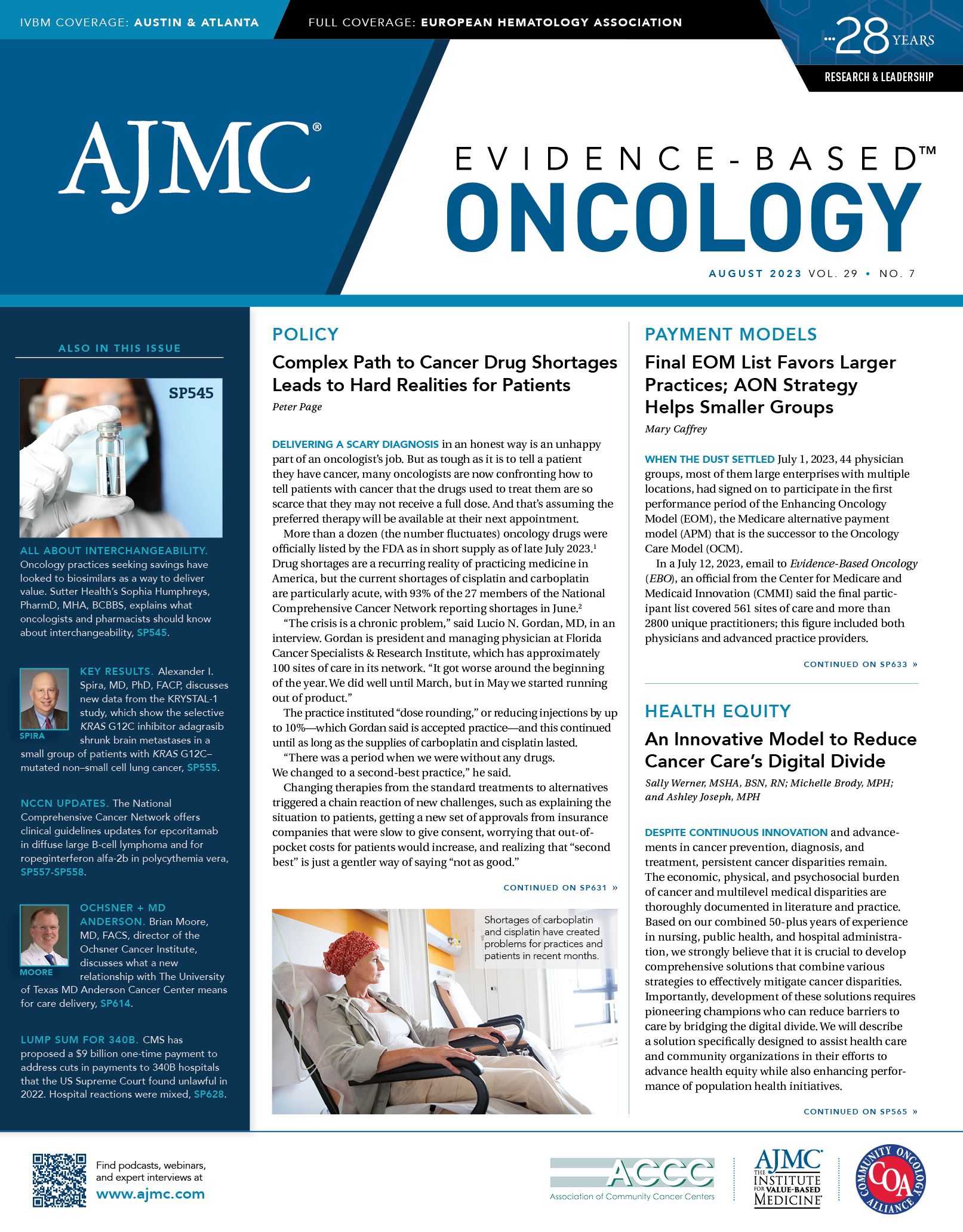Publication
Article
Evidence-Based Oncology
Once a Patient, Digital Health Leader Shares How Texas Oncology Invests in Improved Experiences
Author(s):
Coverage from the June 8, 2023, Institute for Value-Based Medicine session in Austin, Texas, held in partnership with Texas Oncology.
Improving the patient experience requires oncology practices to prioritize the individual and specialized needs of their patients, channeled through digital health platforms, according to a presentation at the June 8, 2023, Institute for Value-Based Medicine event held by The American Journal of Managed Care® in partnership with Texas Oncology. Sydney Townsend, MPA, PMP, executive director of digital health at Texas Oncology, shared how the practice has worked to improve the overall patient experience, as well her own experience as a patient.
Townsend’s Patient Experience
Before becoming an employee at Texas Oncology, Townsend was a patient. She was a new mother and physically active when rib and back pain sent her
Townsend

to a physical therapy and rehabilitation doctor, who knew something more was going on.
“In a matter of 2 or 3 days things…progressed just unbelievably, from it hurts to lift my child to I can no longer walk,” Townsend said. “So I went to see the hematologist/oncologist at Texas Oncology. They told me that I had acute lymphoblastic leukemia.”
This was a dangerous cancer. If her disease had not been stopped quickly, Townsend said, she could have died “in a matter of days.”
She was told to start chemotherapy immediately—to not even pack a bag or say goodbye to her baby. “Everything for the prior 3 months had been completely absorbed in caring for my child, for this little baby. And then suddenly, I really couldn’t even care for myself,” she said. “What really kept me going through this entire journey was just her—to get home to her. My primary oncologist was Dr. Kathryn E. Hudson. And she was in charge of my treatment planning. I felt like she understood because she was a mom herself.”
After 8 rounds of chemotherapy, Townsend was able to receive care at home. She had a telemedicine visit where she was told that she would be OK. “I could be a mom,” she said.
And after 3 years, she went back to work joining Texas Oncology to lead digital health. “And I don’t have to guess at that experience, because I have it,” she said.
By implementing digital health and virtual health strategies, Townsend said, Texas Oncology is determined to meet the specific needs of each patient to give them the best experience possible. By doing so, the practice can offer older patients and their younger caregivers omnichannel opportunities for receiving care. Furthermore, patients can now report more accurately how they are feeling and describe their symptoms as they are experiencing it, rather than recalling their experience later at the clinic.
In her presentation, Townsend emphasized that uplifting and empowering a patient is the reason Texas Oncology does the work that it does.
Financial Benefits of Investing in the Patient Experience
Not only is investing in the patient experience beneficial to patients and the right thing to do, but there are financial gains as well. By defining the patient experience in terms of (PX), “doing the right thing” can result in improved clinical outcomes, address payer pressures, and ultimately help the bottom line.
A Harvard Business Review article, “When patient experience and employee engagement both improve, hospitals’ ratings and profits climb,”1 found better nurse communication and employee engagement resulted in improved hospital ratings and increased profits, in which each 5-point increase in Hospital Consumer Assessment of Healthcare Providers and Systems (HCAHPS) “rate the hospital” survey score was associated with a 1% net profit margin, according to Press Ganey 2017 HCAHPS data.2
The PX Initiative
Reasoning in terms of PX, the patient experience encompasses many aspects of the practice, including wait times, employee satisfaction, patient advisory board, access to clinical, trials, accessibility, nurse navigation, telephony, and more.
Digital health platforms that are also key factors in the patient experience include online scheduling, billing, a patient portal, reminders, referrals, and patient education. Additionally, within the digital care experience is virtual care, which includes telemedicine, telehealth, a health tracker, remote nurse triage, a virtual clinic, telepharmacy, remote patient monitoring, and virtual nurse navigators.
After carefully surveying these key areas within Texas Oncology, their top 5 PX priorities were defined and ranked, starting with the most important, as follows:
- patient engagement,
- new patient time to appointment,
- digital health improvement,
- telehealth supportive care services
- expansion, and
- patient and family advisory council creation.
Improving the patient experience is not something that can be handled half-heartedly. It is something that involves the full attention and engagement from the organization and its employees to identify areas of focus that uplift and empower patients, Townsend emphasized.
Texas Oncology now offers telehealth and virtual appointments for its patients and has had more than 500,000 virtual appointments, including virtual cancer counseling and genetic, palliative, and nutritional care.
References
1. Buhlman NW, Lee TH. When patient experience and employee engagement both improve, hospital ratings and profits climb. Harvard Business Review. May 8, 2019. Accessed August 1, 2023. https://bit.ly/3KiHEXR
2. 2017 nursing special report: the influence of nurse manager leadership on patient and nurse outcomes. Press Ganey.
December 16, 2017. Accessed August 1, 2023. https://bit.ly/
3qa0Bp5

2 Commerce Drive
Suite 100
Cranbury, NJ 08512
© 2025 MJH Life Sciences® and AJMC®.
All rights reserved.





